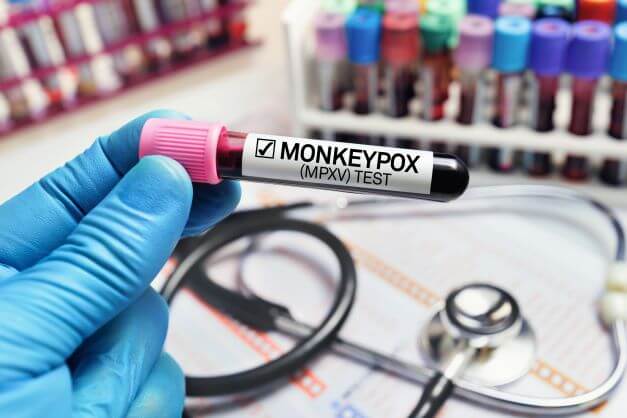Monkeypox has been getting a lot of coverage in the news and on social media lately due to recent outbreaks, but many people aren’t 100% clear on just what monkeypox is or what symptoms they should be looking for. According to Dr. Cuong Le, DO, FAAD of U.S. Dermatology Partners Centerville, “Monkeypox cases in 2022 have reached unprecedented levels. While it’s true that monkeypox can be quite serious, if patients are proactive and seek appropriate care and treatment in the early stages, monkeypox is treatable.” In this blog, Dr. Le will explain what monkeypox is, discuss the warning signs, and explore potential treatment options.
What Is Monkeypox?
Monkeypox is a rare disease caused by the variola virus of the genus Orthopoxvirus. This genus also contains smallpox, camelpox, and cowpox. There are many common misconceptions about monkeypox, including that it’s related to chickenpox and that it comes from monkeys. Monkeypox is not in the same family of viruses as chickenpox, and despite the name, it’s unclear if the virus started in monkeys. Instead, the name is derived from the first recorded breakouts of the monkeypox virus, which were found in research monkeys in 1958. However, where those monkeys got the disease from is still unclear. Monkeypox wasn’t discovered in humans until the 1970s. The current monkeypox outbreak seems to have started in May of 2022 in the U.K. While previous outbreaks cleared up pretty quickly with a few hundred or fewer cases, the 2022 outbreak has nearly 66,000 reported cases, spanning the globe. The majority of cases are reported in areas that have not historically been affected by monkeypox.
How Do You Get Monkeypox?
According to Dr. Le, “Monkeypox is only transmitted through close contact with someone who has an active monkeypox infection. The current thinking is that most of the cases in the current U.S. outbreak are sexually transmitted.” Monkeypox may also be transmitted from person to person through:
- Interactions of any kind that leads to direct contact with a monkeypox sore or rash
- Coming into contact with respiratory secretions of someone with monkeypox
- Touching objects or materials that have had previous contact with a monkeypox rash, sore, or respiratory secretions of the infected person without being sanitized
What Does Monkeypox Look Like?
Monkeypox can present in a number of different ways, but one of the most consistent symptoms across current cases is the presence of a red papule that may be tender or painful and progressively gets worse. Because so many symptoms of monkeypox impact skin health, a dermatologist may be the best medical professional to offer diagnosis and treatment planning. According to Dr. Le, “There are classic symptoms and atypical monkeypox symptoms. The current outbreak is more atypical. Classic symptoms have prodromal signs like fevers or chills with patients developing lesions that progress through stages: flat red macules, papules, pustules, umbilicated papules, or crusted scabs. These lesions can spread and involve the face, trunk, and extremities. In the current outbreak, few people experience systemic symptoms. The areas of the body involved are also different. Classic monkeypox most often impacts the face and extremities, however, this outbreak affects the anogenital region. My most recent patient to present with monkeypox was a male, who had sex with both men and women, with a genital ulcer that he thought was an ingrown hair. He tried to pop it, but the lesion persisted. He denied any systemic symptoms or drainage but did complain of pain and tenderness. These symptoms are not atypical of the most recent outbreak of monkeypox.”
As Dr. Le described, the symptoms of the current outbreak of monkeypox have tended to involve skin rashes that begin as small, painful bumps in the anogenital area or on the hands and feet. Other possible symptoms of monkeypox include:
- Flu-like symptoms, including fever, chills, exhaustion
- Respiratory health issues like cough, sore throat, and congestion
- Swollen lymph nodes
- Headaches, back aches, and general muscle aches
Is Monkeypox Deadly?
When it comes to fatalities related to Monkeypox, Dr. Le says, “In the U.S., a little over 25,000 cases of monkeypox have been reported this year. Of those cases, there has only been one death. Of the nearly 66,000 global cases, there have been 26 deaths this year. The vast majority of people who have died from monkeypox are immunocompromised in some way. While monkeypox can be deadly, it is usually treatable. People need to review and be aware of the symptoms of monkeypox so that they may seek treatment as soon as possible. Since this most recent outbreak seems to be disproportionately impacting members of the LGBTQIA+ community, it’s especially important for these individuals to be aware of symptoms and speak with a professional right away.”
How Can a Dermatologist Help?
In many cases, monkeypox is undiagnosed or misdiagnosed by traditional physicians. According to Dr. Le, “Monkeypox can be swabbed in clinic to identify if it is orthopoxvirus. Confirmation is made by typing to see if it is exactly monkeypox and not camelpox or cowpox. The patient can also go to the health department or their primary care physician for this diagnosis. However, it may be diagnosed more quickly at a board-certified dermatologist’s office since we see a lot of skin health issues, and monkeypox symptoms are primarily a skin manifestation. There are other sexually transmitted diseases or skin disorders that can look similar including herpes, syphilis, acne, or folliculitis. My most recent patient saw urgent care and their primary care physician, and diagnosis was delayed because a viral swab was not obtained. Luckily, the patient decided to come see a dermatologist. Early detection is important because you need to isolate to prevent spread. Additionally, without treatment, monkeypox lesions are painful, and they can leave scars after they heal. If monkeypox is severe, there are treatments that can help decrease the severity. Following a proper diagnosis, physicians can help to develop an appropriate care plan. I also recommend testing for other sexually transmitted diseases.”
Currently, there are no antiviral medications developed specifically to treat monkeypox. However, because they are from the same virus genus, treatments formulated to treat smallpox have proven effective in treating monkeypox. Specifically, tecovirimat (TPOXX) is typically prescribed for monkeypox treatment. Because the U.S. Food and Drug Administration has not specifically approved TPOXX for the treatment of monkeypox, you may need to sign a waiver stating you understand that the medication is investigational. Due to the global outbreak, TPOXX is currently being offered at no cost in most cases for people who test positive for monkeypox. In addition to antiviral medications, your dermatologist or other physician may also provide topical and oral medications to address the skin health and whole-body symptoms of monkeypox to reduce discomfort during healing and recovery.
Vaccinations for monkeypox are available. In the U.S., two vaccines may be used to prevent the spread of monkeypox (JYNNEOS and ACAM2000). The ACAM2000 vaccine is approved to help protect against smallpox and has been made available to protect against monkeypox, but is not recommended for pregnant women, infants less than 12 months old, and those with certain medical conditions such as a weakened immune system, or certain other conditions or circumstances, such as heart conditions and certain skin conditions. Both vaccines are expected to provide a good level of protection against monkeypox.
Can I Schedule an Appointment with Dr. Le?
For those who live in the Centerville, VA area, Dr. Le or one of the other knowledgeable dermatologists at U.S. Dermatology Partners Centerville will be happy to partner with you to treat monkeypox or any other skin conditions you may be dealing with as well as provide your annual professional skin exams. We also have more than 90 dermatology office locations in seven additional states. If you’re interested in learning more, simply take a few minutes to complete our online scheduling request form. Once team members at our local dermatology office hear from you, they’ll be in touch to finalize the details of your appointment.
Find a location near me
or


